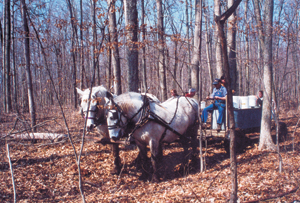ITS THE SWEET SEASON

When I arrived at “Sugar Camp” it was a beautiful sunny morning. Jack, the owner, was off to town. The sump pump used in the process of moving the sap from one container to another had quit. So Jack needed to find another one. By the time Jack was back from town, many of Jack’s friends, neighbors, and relatives had arrived, all to give Jack a hand, and experience “Sugar Camp”.
I introduced myself. Jack said, “Oh, you’re the one from Waynedale. Janet, my niece, said you were coming. Let’s hitch the team.” So off we went to the barn where the horses were tied. Two dappled Percherons were chosen. Jack harnessed the team and kept them tied in the barn while we walked back to the Sugar House. At the Sugar House, the sump pump had been replaced by Jack’s son, Tim, who was now preparing the boiler/furnace for processing the syrup.
The team of Percherons, used to draw the wagon that carries a 200-gallon holding tank, was brought up from the barn and hitched. “Everyone find a place to sit and hold on. It’s just a bit down to the trees,” Jack announced, as we found a seat on the holding tank.
When we arrived at the Sugar Grove (the group of sugar maples for syrup production) everyone eagerly jumped off the wagon and grabbed a plastic 5-gallon collection bucket. Metal “spiles” had been inserted or tapped into holes made by a drill on each maple tree a few days before the sap was expected to start running. At each tapped tree, the sap was poured from the buckets that hung off the tree into the plastic collection bucket. When the collection bucket was full it would be emptied into the holding tank pulled by the horses.
The bucket collection method has some advantages (for example, it is possible to measure exactly how much sap individual trees are producing) it is however, time-consuming and hard work. “I’m so thankful for all this help each year, I don’t think that I could do it all alone.” (Many of the large producers are now using plastic tubing that drains sap from the trees directly into their Sugar Houses or storage tanks). Jack informed me that there were around 300 taps in his trees this year.
We were all kept busy running pails of sap from the trees to the collection tank on the wagon. All except for “Farmer” the dog, and Jack, who tended the horses pulling the wagon. “On the sunny side of a free-flowing tree, the small sap buckets might fill in a day,” Jack explained. “It’s pretty rare, but once I saw them fill in 4 hours!” Maple syrup has a long history dating back as far as the Indians Jack informed me. The Indians called the maple syrup “sweet water.” This particular stand of sugar maples has been identified as a “Classified Forest”. There is no burning or pasturing allowed. Jack’s records date back as far as 1844 when his family first bought the farm. And last year, Jack Gaby’s farm was recognized as being one of the oldest continually farmed properties in Noble County. Jack proudly proclaimed that he was born, raised, and still lives on this property.
Once the sap is collected and brought back to the Sugar House, the boiling process begins. It takes 30 to 40 gallons of sap to yield a gallon of syrup. Sap is placed in a holding tank and then runs into the boiler or furnace, over a heat source and the water is evaporated. Sap becomes maple syrup when enough water has boiled off to leave a sugar concentration of about 67%.
I enjoyed the “sweet season” at Jack Gaby’s Sugar Camp. If you plan on visiting a Sugar Camp next year, call ahead, it is a very short season running for only a month.
- ‘Sounds Of The Season’ Concert Series & Toys For Tots Partnership - November 7, 2025
- Pets Available At Reduced Or No Fee - November 7, 2025
- Local Food Assistance Takes Spotlight During National Debate - November 7, 2025







